Leonidas
Leonidas (Greek Λεωνίδας): king of Sparta from the Agiad dynasty (r.488-480), killed in action in the battle of Thermopylae.
Accession
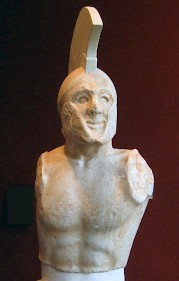
It was not written in the stars that Leonidas would become king of Sparta. He was the third son of Anaxandridas, king from the Agiad Dynasty (r.c.540-c.520).note However, the second son, Dorieus, was killed in action when he tried to establish a colony on Sicily,note while the first son, Cleomenes, succeeded his father as king and had reigned from c.520 until 488 BCE, but committed suicide.note Now, Leonidas became king: he was not only the third son, but was also married to Cleomenes’ daughter Gorgo.note
The story of Cleomenes' suicide, told by the Greek researcher Herodotus of Halicarnassus,note is suspect: the author of the Histories may in fact be repeating a cover-up of what may in fact have been the murder of a king who had become a threat to the existing order. If this is indeed true, Leonidas' reign started with a coup d'état.
Xerxes' Invasion of Greece
In 480 BCE, the Persian king Xerxes invaded Greece – something that the Greeks had expected to happen. After all, the Persians had built a bridge across the Hellespont,note and had cut a canal through the Athos,note more or less indicating what they wanted to do. Heralds had been asking for “earth and water”,note i.e., demanding surrender.
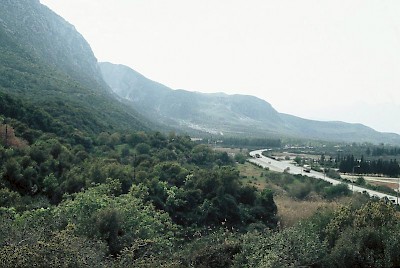
The Greek city states had decided to fight and first tried to block the Persian advance in the Tempe canyon between the mountains Olympus and Ossa.note When they discovered that the pass could be turned, they retreated to the south: their navy would wait for the Persian navy at Artemisium, their army would occupy Thermopylae.note Leonidas was to be the commander of this army, which consisted of three hundred elite hoplites from Sparta and about 3700 other men.note By occupying this position, the Spartans and their allies would prevent the Persian army from attacking the Greek navy in the rear.
Although Leonidas knew that the defense would be difficult and that many men would not return (he selected only soldiers who already had sonsnote), there is no need to assume that this was some kind of kamikaze or self-sacrifce. In Antiquity, Thermopylae was more narrow than today; the sea reached as far inland as the modern road (cf. this photo). It was defensible and that the defense was seriously meant can be deduced from the simple fact that Leonidas ordered the paths in the mountains to be guarded as well.note
Battle
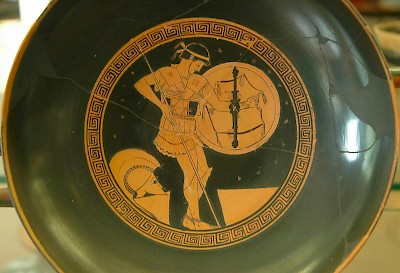
Although Herodotus believes that it was coincidence that the three-day naval battle of Artemisium took place on the same days as the three-day battle of Thermopylaenote (17, 18, 19 September or one day later), it probably was no coincidence: Xerxes waited four days before he ordered the advance to Thermopylae, to synchronize this attack with the fight at Artemisium.
On the first day of the battle, Xerxes sent the Median and Elamite contingents, which were easily repelled by the defenders of the narrow road.note A second wave of troops consisted of the ten thousand Immortals, the royal bodyguard. These elite troops did no better.note
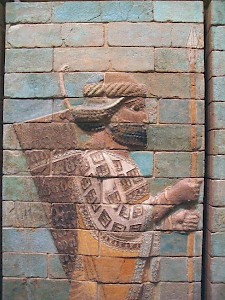
The Persian position did not improve during the second day of battle.note When Xerxes' soldiers passed through the narrow gap, they were killed by their opponents, who had longer spears and better armor. Against the Greek hoplites, the Persians were no match. Many of them fell into the sea and drowned.
If we are to believe Herodotus, it was at this moment that a Greek named Ephialtes told the great king about the possibility to turn the position of the Greek army: there was a mountain path.note The story is hardly credible: the Persian scouts were probably perfectly capable of finding the path themselves. Anyhow, during the night, the Immortals, commanded by Hydarnes, made a detour and attacked the Greek contingent that guarded the path.note The exact route of this detour cannot be identified.
The Unsolved Riddle
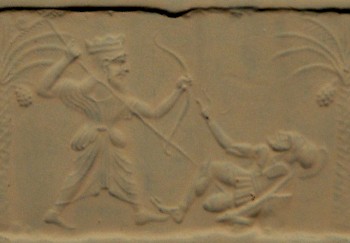
At the beginning of the third day, the Greeks learned that the Persians would soon descend from the mountains and attack their rear.note At this point, Herodotus' account becomes confused. In one line,note he says that many Greeks decided to leave and abandoned Leonidas. In the next line, he says that there were also reports that Leonidas commanded them to go away.note However this may be, only the Spartans (the 300 elite hoplites and 900 helpers), 700 Thespians, and 400 Thebans remained.
It is possible that they also wanted to leave, but were trapped when the Immortals arrived. The historian Charles Hignett has famously called the reason why Leonidas stayed "an unsolved riddle", and there's little to add to that conclusion.
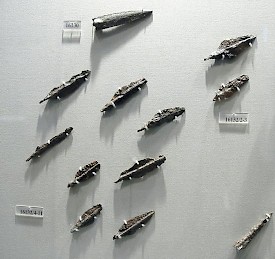
Herodotus admits that he is puzzled. Having said that the people abandoned Leonidas and having offered the other interpretation, he wonders why Leonidas might have ordered the soldiers to stay. What follows is introduced with the word gnomê,note which Herodotus usually uses when he offers a personal opinion: Leonidas decided to stay because an oracle had announced that Sparta would either be destroyed or lose its king. Leonidas preferred the second alternative.
It may well be true. Devotio was not unheard ofnote and what's more, the oracle well fits within the context of Sparta's wars against Argos and may therefore be authentic. However, it also smells of propaganda, and the story may well have been invented during the difficult months between the defeat at Thermopylae and the victory at Plataea, in order to inspire the Greeks.
Endgame
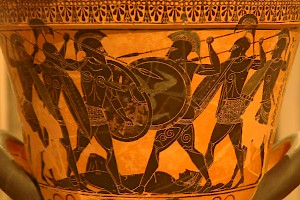
Reportedly, Leonidas ordered his men to go forward against their opponents, who were lashed towards the Spartans by their officers.note When Leonidas fell, a bitter struggle over his body broke out. Herodotus tells that the Greeks drove off their enemy four times, and finally succeed in dragging the corpse away.note This is too homeric to be true (compare the fight for Patroclus' body in the Iliad), and again we do not know if this really happened: those who were close to Leonidas, did not live to tell their stories.
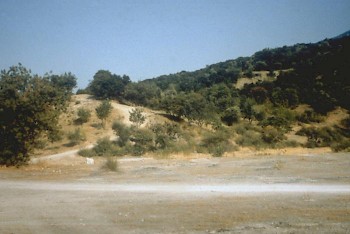
After the death of Leonidas, the surviving Greek soldiers retreated to a small hill, where they were killed by Persian archers. As it happens, archaeologists have found several arrowheads.
Aftermath
After the fall of Thermopylae, the road to Greece was open. Artemisium was evacuated, and it became unavoidable that Thebes would be captured and Athens sacked. It was only during the naval battle of Salamis that Greece's fortunes were restored, although the winter of 480/479 was an uneasy one, and it was only in the summer of 479 that the Persians were decisively defeated.
Leonidas had a son named Pleistarchus, who was too young to succeed his father; instead, Leonidas’ youngest brother Cleombrotus and (later) his relative Pausanias was appointed as regent of his cousin.note Leonidas' wife Gorgo may have been one of the sources of Herodotus.